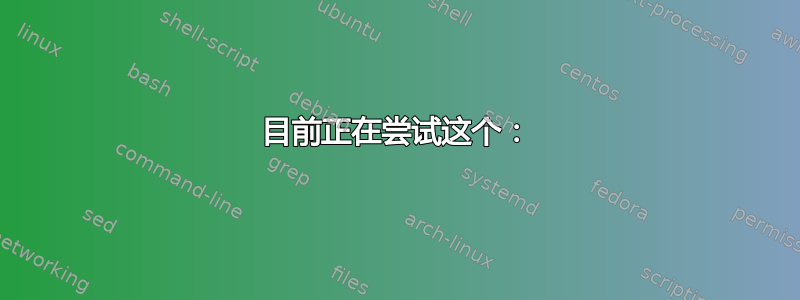
我对最简单的解决方案感兴趣,身份验证实际上甚至不必测试用户/密码对...它只需进行 http 身份验证质询。我正在尝试在代理上为我正在开发的库测试 http 身份验证。
我已经实现了一个返回“ok”的脚本作为我的程序使用,如下所示:
auth_param basic realm Squid proxy-caching web server auth_param basic
program /usr/local/bin/ok
鱿鱼死了,这是我的日志中显示的内容:
2012/03/13 13:09:24| WARNING: basicauthenticator #1 (FD 12) exited
2012/03/13 13:09:24| WARNING: basicauthenticator #2 (FD 14) exited
2012/03/13 13:09:24| WARNING: basicauthenticator #3 (FD 16) exited
2012/03/13 13:09:24| WARNING: basicauthenticator #4 (FD 18) exited
2012/03/13 13:09:24| Too few basicauthenticator processes are running
2012/03/13 13:09:24| storeDirWriteCleanLogs: Starting...
2012/03/13 13:09:24| Finished. Wrote 0 entries.
2012/03/13 13:09:24| Took 0.00 seconds ( 0.00 entries/sec).
FATAL: The basicauthenticator helpers are crashing too rapidly, need help!
Squid Cache (Version 3.1.19): Terminated abnormally.
CPU Usage: 0.014 seconds = 0.008 user + 0.006 sys
Maximum Resident Size: 5709824 KB
Page faults with physical i/o: 0
文档中有一个可能相关的参考,但我不确定如何实现:
# If you use an authenticator, make sure you have 1 acl of type
# proxy_auth.
目前正在尝试这个:
http://www.cyberciti.biz/tips/linux-unix-squid-proxy-server-authentication.html
答案1
类似这样的事情应该可以工作:
acl example proxy_auth REQUIRED
http_access allow example
为了保持一致性,您可以与 LDAP 一起使用以下配置:
auth_param basic program /usr/lib/squid/ldap_auth -ZZ -b "dc=example,dc=com" -f "(&(uid=%s)(!(gn=noaccess))(!(cn=noaccess)))" -h ldap.example.org -v 3
acl ldap proxy_auth REQUIRED
http_access allow ldap
http_access deny all
它的作用是尝试通过 LDAP 服务器 ldap.example.org(最好使用 IP 地址)使用 uid 对用户进行身份验证,并且当 gn 等于“noaccess”或 cn 等于“noaccess”时,它将不允许访问。
它将拒绝访问其他所有内容。
答案2
很棒的文章--http://www.cyberciti.biz/tips/linux-unix-squid-proxy-server-authentication.html
最终使用了以下内容:使用风险自负...因为我不知道它的作用。
#proxy auth
auth_param basic program /usr/local/libexec/ncsa_auth /usr/local/etc/passwd
auth_param basic children 5
auth_param basic realm Squid proxy-caching web server
auth_param basic credentialsttl 2 hours
auth_param basic casesensitive off
#auth_param basic program /usr/local/bin/err
acl ncsa_users proxy_auth REQUIRED
http_access allow ncsa_users
#
# Recommended minimum configuration:
#
acl manager proto cache_object
acl localhost src 127.0.0.1/32 ::1
acl to_localhost dst 127.0.0.0/8 0.0.0.0/32 ::1
# Example rule allowing access from your local networks.
# Adapt to list your (internal) IP networks from where browsing
# should be allowed
acl localnet src 10.0.0.0/8 # RFC1918 possible internal network
acl localnet src 172.16.0.0/12 # RFC1918 possible internal network
acl localnet src 192.168.0.0/16 # RFC1918 possible internal network
acl localnet src fc00::/7 # RFC 4193 local private network range
acl localnet src fe80::/10 # RFC 4291 link-local (directly plugged) machines
acl SSL_ports port 443
acl Safe_ports port 80 # http
acl Safe_ports port 21 # ftp
acl Safe_ports port 443 # https
acl Safe_ports port 70 # gopher
acl Safe_ports port 210 # wais
acl Safe_ports port 1025-65535 # unregistered ports
acl Safe_ports port 280 # http-mgmt
acl Safe_ports port 488 # gss-http
acl Safe_ports port 591 # filemaker
acl Safe_ports port 777 # multiling http
acl CONNECT method CONNECT
#
# Recommended minimum Access Permission configuration:
#
# Only allow cachemgr access from localhost
http_access allow manager localhost
http_access deny manager
# Deny requests to certain unsafe ports
http_access deny !Safe_ports
# Deny CONNECT to other than secure SSL ports
http_access deny CONNECT !SSL_ports
# We strongly recommend the following be uncommented to protect innocent
# web applications running on the proxy server who think the only
# one who can access services on "localhost" is a local user
#http_access deny to_localhost
#
# INSERT YOUR OWN RULE(S) HERE TO ALLOW ACCESS FROM YOUR CLIENTS
#
# Example rule allowing access from your local networks.
# Adapt localnet in the ACL section to list your (internal) IP networks
# from where browsing should be allowed
http_access allow localnet
http_access allow localhost
# And finally deny all other access to this proxy
http_access deny all
# Squid normally listens to port 3128
http_port 3128
# Uncomment and adjust the following to add a disk cache directory.
#cache_dir ufs /usr/local/var/cache 100 16 256
# Leave coredumps in the first cache dir
coredump_dir /usr/local/var/cache
# Add any of your own refresh_pattern entries above these.
refresh_pattern ^ftp: 1440 20% 10080
refresh_pattern ^gopher: 1440 0% 1440
refresh_pattern -i (/cgi-bin/|\?) 0 0% 0
refresh_pattern . 0 20% 4320


